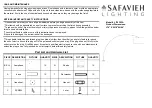
11
Adapters for 3 or 5 pin XLR
Systems using a mix of 3 and 5 pin XLR DMX interfaces can be accommodated by
purchasing adapters or building adapter cables. Numbers designating each pin can be
found on connectors. Converting between the two XLR types is done pin-to-pin. Shield
wire connects to pin 1, then connect pin 2 to pin 2 and pin 3 to pin 3, regardless of either
connector’s gender or pin count. No connection is made to Pins 4 & 5.
DMX Start Address
More than one fixture may have the same start address, but they will behave the same.
Giving a unique start address that does not overlap with any other units allows you to
individually control that fixture’s features fully. Never allow channels to overlap. This
fixture features a 3 channel DMX mode. This will determine the spacing of channels you
will need to avoid overlapping of channels when selecting your start addresses.
Example
Select Start Addresses for 4 fixtures each requiring 3 channels of DMX.
For this example, start with the first unit set to the first possible Start Address =
1
. This fixture
occupies DMX channels 1 thru 3. The next DMX channel available for a Start Address is found
by adding the previous fixture’s Start Address to its channel requirement: 1+3=
4
. To maximize
channel usage leave no empty channels between fixtures, so the second Start Address is set to
DMX channel 4 and that fixture occupies channels 4 thru 6. The third fixture will be addressed
4+3=
7
and occupy channels 7 thru 9. The last fixture is addressed 7+3=
10
and will occupy
channels 10 thru 12. Thus, 4 fixtures using 3 channels each have Start Addresses of
1, 4, 7
and
10
, leaving the next free channel in the system is 10+3=13.
5 Pin XLR (Plug)
Pin 1: GND(Sheild)
Pin 2: Signal(-)
Pin 3: )
Pin 4: N/C
Pin 5: N/C
3
XLR (S
)
Pin 1: GND(Sheild)
Pin 2: Signal(-)
Pin 3: )
Pin
ocket
5 Pin XLR (Socket)
Pin 1: GND(Sheild)
Pin 2: Signal(-)
Pin 3: )
Pin 4: N/C
Pin 5: N/C
3
XLR (Plug)
Pin 1: GND(Sheild)
Pin 2: Signal(-)
Pin 3: )
Pin


































